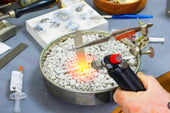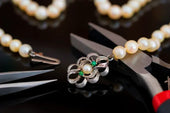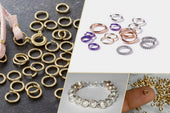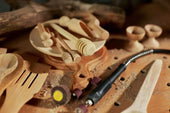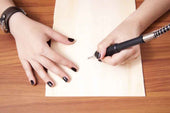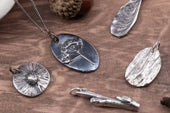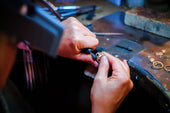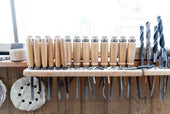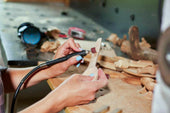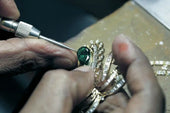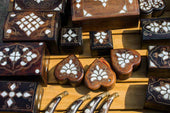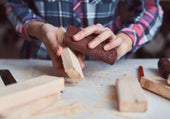Whether you work with wood, stone or soap, carving is an art that requires both skills and the right equipment. However, even the best tools will fail if they are not properly cared for. Maintaining your engraving tools is not merely about safeguarding your investment, but also about ensuring consistent performance, safety and enjoyment with each creation.
Here is a complete guide to take care of your engraving tools so that they can serve you well for several years, or even decades, in the future.
1.Keep Your Tools Razor-Sharp
A sharp blade glides through material effortlessly, giving you clean cuts and full control over your work. A dull blade, on the other hand, can slip, tear wood fibers, or even cause injury.
How to sharpen effectively:
Use a sharpening stone or diamond stone for honing the edge.
Maintain the correct angle—usually 20–25° for most wood carving knives.
After sharpening, polish the edge with a leather strop and polishing compound to remove any burrs.
For curved tools like gouges or V-tools, use a slipstone or specialized sharpening jig.
Tip: Don’t wait until your tools are completely dull. Regular maintenance stropping after each session greatly prolongs edge retention and saves time in the long run.
2.Clean Your Tools After Every Use
Dust, resin, sap, and moisture from carving materials can degrade your tools if left untreated.
Cleaning checklist:
Wipe blades with a soft microfiber cloth after each session.
For sticky residue, use mineral spirits or denatured alcohol (sparingly).
Avoid water on metal surfaces; if used, dry immediately.
Clean stone or soapstone dust with a soft brush or light air blower to avoid abrasive buildup.
After cleaning, apply a thin coat of protective oil to the blade. Camellia oil, mineral oil, or tool-specific rust inhibitors are ideal.
3.Prevent Rust and Corrosion
Rust is the silent killer of steel tools. Once it takes hold, it can pit the metal and ruin precision edges.
Prevention tips:
Store tools in a dry, humidity-controlled environment.
Use silica gel packs, dehumidifiers, or rust-inhibiting paper in your toolbox.
Apply a rust-preventive oil every few weeks, especially in humid climates.
Avoid storing tools in leather sheaths long-term, as they can trap moisture.
4.Take Care of Wooden Handles

The blade may do the cutting, but the handle does the guiding. A cracked or loose handle compromises both safety and performance.
Handle care essentials:
Treat wooden handles with boiled linseed oil, tung oil, or beeswax to keep them hydrated and prevent splitting.
Avoid prolonged exposure to sunlight or damp environments.
If a handle loosens, re-seat it firmly with wood glue or replace it entirely.
Loose handles are not just an inconvenience—they can lead to blade control issues or accidents. Always inspect before use.
5.Store Tools Safely and Intelligently
Storage is often overlooked, but it’s crucial. Poor storage leads to chipped blades, rust, or even injuries.
Best storage practices:
Use tool rolls, magnetic strips, or foam-lined drawers to keep tools separated and protected.
Label tools by type or function for quick access.
For portability, use hard cases with custom foam inserts to prevent shifting and collision.
If working outdoors, never leave tools exposed to rain or damp soil—carry a clean towel or cloth for quick wraps.
6.Use the Right Tool for the Right Job
It may be tempting to use a fine detail knife for roughing, or a gouge as a lever—but improper use is the fastest way to destroy your tools.
Tips for proper use:
Learn the strengths of each tool—don’t substitute.
Match your tool to the hardness of the material.
Avoid applying excessive pressure. If the tool isn’t cutting, it likely needs sharpening, not more force.
7.Develop a Routine and Log Maintenance
Just like you would tune an instrument or service a car, carving tools benefit from routine checkups.
Make it a habit:
Set aside 10 minutes after each session for cleaning and oiling.
Schedule monthly deep maintenance: sharpening, handle checks, rust inspection.
Keep a maintenance log if you own many tools or teach classes—it helps track usage and replacement needs.
Final Thoughts: Respect Your Tools, and They’ll Respect You
Carving is not only a craft, but also a dialogue between your hands, tools and imagination. Maintaining your tools is not a trivial matter - it is part of the art. Regularly pay attention to sharpness, cleanliness, storage and correct use, and your engraving tools will remain in the best condition and continue to help you turn raw materials into timeless works of art.


